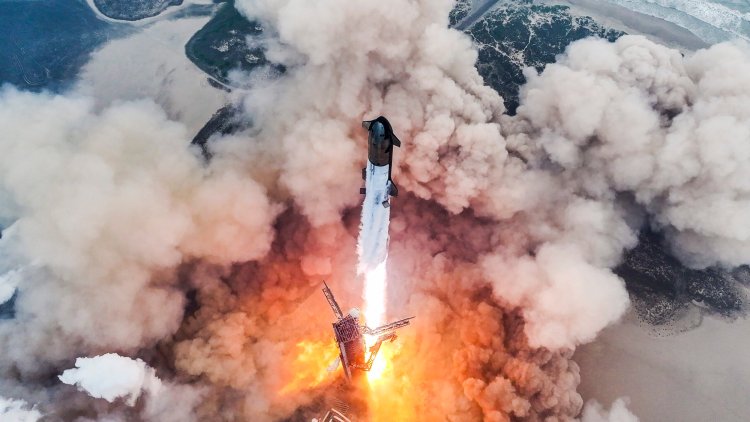SpaceX Starship’s Fourth Test Flight Is Rocket’s Most Successful Yet
It’s a momentous occasion for SpaceX as both Starship and the Super Heavy booster successfully splashed down back on Earth. The post SpaceX Starship’s Fourth Test Flight Is Rocket’s Most Successful Yet appeared first on FLYING Magazine.

A damaged flap and multiple lost tiles weren’t enough to stop SpaceX’s Starship—the largest and most powerful rocket ever constructed—from making its first successful splashdown on Thursday.
Starship and the Super Heavy booster finally made it back to Earth following the spacecraft’s fourth integrated flight test (IFT-4), which was the main goal of the mission that launched from Boca Chica, Texas. As SpaceX put it, “the payload for this test was the data.”
Super Heavy splashed down in the Gulf of Mexico after jettisoning from Starship about four minutes into the flight. Starship, meanwhile, flew nearly halfway around the world over the course of about 40 minutes before splashing down in the Indian Ocean.
External cameras and on board Starlink satellites gave viewers a rare live look at Starship’s reentry into Earth’s atmosphere from its suborbital flight path. The video feed appeared to show the loss of several heat shield tiles and damage to one of the flaps—which control the vehicle as it decelerates from hypersonic speeds—as plasma built up around the spacecraft.
Live footage cut in and out several times, prompting cheers from the SpaceX team each time the feed was restored. Crews toasted marshmallows in celebration of Starship’s inaugural landing burn, which slowed it down for a “soft” ocean landing. Then, finally, after much anticipation, the gargantuan spacecraft splashed down for the first time at T-plus 1 hour and 6 minutes.
“Despite loss of many tiles and a damaged flap, Starship made it all the way to a soft landing in the ocean!” said SpaceX CEO Elon Musk in a post on X, the social media platform he acquired in 2022. “Congratulations @SpaceX team on an epic achievement!!”
NASA Administrator Bill Nelson, who is betting on Starship to complete the necessary test flights in time for SpaceX to prepare a Starship Human Landing System (HLS) for the Artemis III mission—NASA’s first lunar landing attempt since the Apollo missions—also sang the praises of IFT-4.
After successfully making it to suborbit and back, the arrow is pointing up for Starship.
Each of the spacecraft’s first two integrated test flights ended in explosions, and its third was cut short just after reentering the atmosphere. All three attempts resulted in the spacecraft’s grounding by the FAA.
But SpaceX painted these as successes. According to the company, Starship’s development falls under its philosophy of rapid design iteration. Essentially, the firm is okay with blowing up a few rockets if it can collect data that helps it hone the design, increasing the chances of success on future launches.
A reentry and soft landing was the primary objective of Thursday’s flight test, validating that Starship and Super Heavy—which are designed to be reusable—could survive the extreme conditions during approach and landing.
At present, it’s unclear whether the extent of the damage will prevent the rocket from flying again. But with both stages back on Earth, it seems unlikely that the FAA would move to ground Starship for a fourth time.
“The fourth flight of Starship made major strides to bring us closer to a rapidly reusable future,” SpaceX said in an update on its website. “Its accomplishments will provide data to drive improvements as we continue rapidly developing Starship into a fully reusable transportation system designed to carry crew and cargo to Earth orbit, the moon, Mars, and beyond.”
That would mean Musk and SpaceX can turn to the next step in Artemis preparations: an in-orbit propellant transfer demonstration. Following that, Starship will need to complete an uncrewed lunar landing, which could require multiple launches.
The final phase will be a crewed flight test, in which the spacecraft will land billionaire entrepreneur Jared Isaacman on the moon. Isaacman is the driving force behind the Polaris Program, which in 2022 purchased three flights from SpaceX in an effort to advance human spaceflight. The program’s first mission, Polaris Dawn, is expected to launch this summer on SpaceX’s Falcon 9 rocket. It will culminate in the crewed flight of Starship.
It’s difficult to gauge exactly how many Starship launches SpaceX will need to complete before the rocket is certified for routine missions. But the company is under a time crunch.
Already, Artemis III has been pushed back from 2025 to September 2026. And NASA, facing competition from Russia, China, and others to expand the envelope for human spaceflight, will likely want to stick to that timeline.
If that’s the case, SpaceX will need to see continued positive results from rapid design interaction. The good news is that Starship appears to be on the right trajectory.
Like this story? We think you’ll also like the Future of FLYING newsletter sent every Thursday afternoon. Sign up now.
The post SpaceX Starship’s Fourth Test Flight Is Rocket’s Most Successful Yet appeared first on FLYING Magazine.
What's Your Reaction?












![[Computex] The new be quiet cooling!](https://technetspot.com/uploads/images/202406/image_100x75_6664d1b926e0f.jpg)







